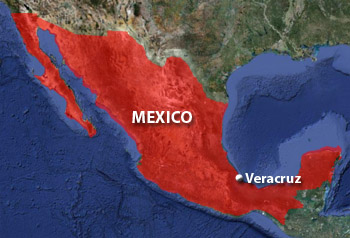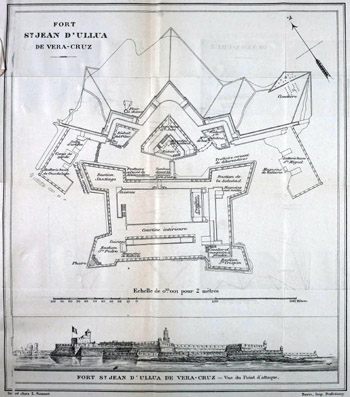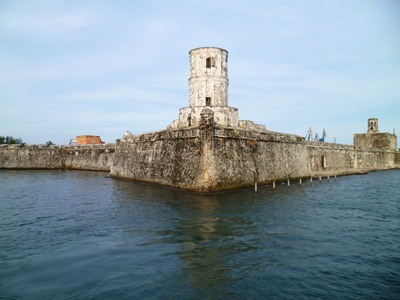 |
Fortaleza de San Juan de Ulúa
Veracruz, Mexico
|
|
 |
When Spanish explorer Hernán Cortéz (1485-1547) landed at the location of our current interest in 1519, he bellowed HEY WHAT A COOL PORT THIS WOULD MAKE and founded the city of Villa Rica de la Vera Cruz, referring to gold, the True Cross, the holy day on which he discovered this spot, and the Spanish compulsion to give things really long and convoluted names. Veracruz was the first Spanish settlement on the mainland of the Americas!
A ship captained by Juan de Grijalva (1489-1527) landed on the island of San Juan de Ulúa in 1518, which is where our fort resides, but it's an island kind of dipping into Veracruz's harbor, so we can pretend Cortéz is the bigshot in this situation.
|
 |
 |
|
The name Ulúa is derived from the word Aztec in a way that I don't quite get, but there were certainly Aztecs scampering about sacrificing each other in this region at the time. The Spanish had themselves a fine port, but the little river that led inland from that point was too shallow for oceangoing vessels. Ships anchored at San Juan de Ulúa and littler boats ferried goods into & out of the mainland. An observation tower was built on the island to ensure that all goods were passing before the eyes of customs officials.
|
 1838: Click on it, it's huge. 1838: Click on it, it's huge. |
 |
Indigenous peoples were killed off in various ways as tended to be the case, and African slaves were imported to work on sugarcane plantations. Treasure from the crumbling Aztec civilization was flowing through Veracruz to Spain in ever increasing amounts, which attracted pirates, and this is what finally prompted the construction of the Fortaleza de San Juan de Ulúa, beginning in 1565.
In September of 1568, an English minifleet of five ships, led by Jack Hawkins (1532-1595) and including a young Francis Drake (1540-1596), was parked at San Juan de Ulúa, refitting and preparing to return home after a year of piratical behavior at the expense of Spain. A Spanish fleet approached, but the Brits felt secure, holding several Spanish hostages aboard their vessels, and agreed to allow the Spanish ships to anchor nearby.
To Hawkins' surprise, the Spanish acted just as ruthlessly as would an Englishman by breaking the truce and attacking.
|
|
|
All of the loot that the English fleet had collected over a year's plundering was reclaimed by Spain, and only two of the English ships escaped: One captained by Drake, who would go on to be a huge hero in Britain and wicked devil to Spain in a long and entertaining naval career. Drake was second in command of the English Navy's defense against the Spanish Armada's attempted invasion in 1588.
In May of 1683, an all-star group of European pirates allied to capture Veracruz, where they plundered merrily and took 4000 prisoners, then hunkered down to wait for ransom money to appear in spontaneous piles at their feet. A Spanish fleet arrived and glared in a menacing fashion, whereupon the pirates gave up on the ransoms, boarded their ships and sailed off without further incident, seemingly under the eyes of the Spanish Navy. We know you can do damage, Spanish Navy. Do it to pirates. They deserve it.
|
 In the process of lovingly admiring San Juan de Ulúa's southwestern pointy tip, we learn that it's not only the Portuguese who go for those weird little dingleberries on their starfort tips. Cover it up with all the messy pieces of wood you want, it's still a dingleberry. For shame, imperial Spain. In the process of lovingly admiring San Juan de Ulúa's southwestern pointy tip, we learn that it's not only the Portuguese who go for those weird little dingleberries on their starfort tips. Cover it up with all the messy pieces of wood you want, it's still a dingleberry. For shame, imperial Spain. |
 |
From 1810 to 1821, Mexico fought to free itself from Spain's colonial shackles. Spanish troops occupied Veracruz to keep the sea lane betwixt Mexico City and Madrid operational, but by the end of the conflict San Juan de Ulúa was Spain's last bastion in Mexico.
The Treaty of Cordóba was signed by representatives of the Spanish crown at San Juan de Ulúa on August 24 1821, establishing Mexico's independence from Spain. Spanish troops would continue to garrison the fort until November of 1825, when they were finally expelled after having fired upon the city their fort was originally intended to protect.
The years following Mexico's independence from Spain were pretty unpleasant for just
|
|
about everybody involved. Mexico enjoyed the stability that can only be achieved by having 20 presidents in 20 years: Corruption, politically inspired murder, mass arrests and general nuttiness ensued. Around 6000 French folks had settled in Mexico, and their shrill cries were received with mounting concern by France.
The French government was finally spurred into action in 1837 when a French pastry chef named Remontel, established in the Mexican city of Tacubaya, had his stores raided by drunken Mexican soldiers: Kill our citizens, rape our women, whatever...but hinder our pastry chefs and we've got a problem, screamed France.
The Pastry War, which I am not making up, brought a French fleet to Veracruz in 1838, where they set about bombarding San Juan de Ulúa. The port of Veracruz was captured by the French, who continued to ravage all of Mexico that they could get to with the righteous indignation borne by those concerned with pastry. In 1839 Great Britain finally said oh my God this is ridiculous, and diplomatically intervened. The French left Veracruz on March 9 1839, smugly certain that Mexico would never again besmirch a pastry.
|
Veracruz was occupied once again by American troops in 1848 during the Mexican-American War (1846-1848). In the 1860's the Spanish returned and occupied Veracruz in an effort to collect unpaid debts, and the French, looking to install their Austrian stooge Maximilian I (1832-1867) as Emperor of Mexico while the US was occupied with tearing itself to shreds, drove Mexican president Benito Juárez (1806-1872) out of Mexico City: Spain had by then left Veracruz, unwilling to participate in France's silliness, so Juárez shoved some prisoners aside and took up residence at San Juan de Ulúa in 1857.
|
 |
|
|
Maximilian I was finally captured and shot by Republican forces in May of 1867: Yay, San Juan de Ulúa could go back to just being a prison again!
Indeed, our fort was so far removed from being an actual fort that it played no role whatsoever in the battle to keep US Marines and armed sailors from capturing Veracruz in April of 1914. Eight US sailors had been arrested by Mexican soldiers in what was essentially a misunderstanding at the city of Tampico, brought on in part by the anarchy that was the Mexican Revolution (1910-1920). Although Mexican president Victoriano Huerta (1850-1916) apologized and immediately released the sailors, he refused to raise the US flag on his territory and fire a 21-gun salute as further apology...so in swept the Marines and sailors from US warships, to capture Veracruz for what one certainly hopes was the last time. US troops remained in Veracruz until November 23 1914.
San Juan de Ulúa rotted quietly for many decades, but was extensively renovated in recent years and is now a popular tourist attraction that, we are admonished, is not to be missed if one knows what is good for one. Some scenes in the 1984 movie Romancing the Stone were shot at San Juan de Ulúa. Hey, I finally have a reason to watch Romancing the Stone!
|
|
|
|
|
|
 |




